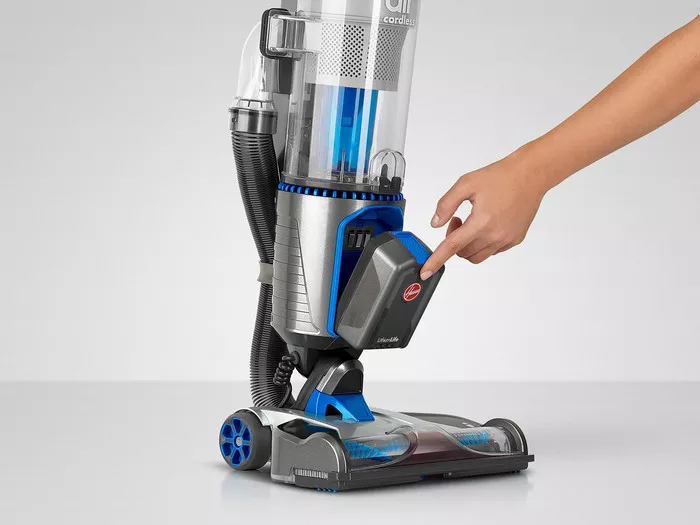The fundamental scientific principle behind the operation of a vacuum cleaner is the creation of a pressure difference, akin to sipping a drink through a straw. Just as sipping creates a lower pressure inside the straw compared to the ambient pressure outside, a vacuum cleaner works by creating a similar pressure differential to draw in air along with dust and debris.
Main Components
Intake Port and Exhaust Port
The intake port is where air, along with dirt and debris, enters the vacuum cleaner. The exhaust port expels filtered air back into the environment. Both ports are strategically located to optimize airflow and suction efficiency.
Electric Motor
The electric motor is the powerhouse of the vacuum cleaner. It drives the fan and creates the necessary suction force to lift dirt and debris from surfaces.
Fan
The fan is responsible for generating airflow within the vacuum cleaner. As the fan rotates, it creates a low-pressure area behind it, drawing in air and any particles in its path.
Porous Bag
In traditional bagged vacuum cleaners, the porous bag serves as a filter, trapping dirt and debris while allowing air to pass through. This ensures that only clean air is expelled back into the environment.
Housing
The housing encases and protects the internal components of the vacuum cleaner, providing structural integrity and stability.
Process of Suction
The process of suction begins with the electric motor powering the fan. As the fan rotates, it creates a centrifugal force that propels air towards the exhaust port. This movement of air creates a pressure drop inside the vacuum cleaner, resulting in a partial vacuum.
Types of Vacuum Cleaners
Upright
Upright vacuum cleaners are commonly used in households and feature a vertical design. They are well-suited for cleaning carpets and large floor areas efficiently.
Canister
Canister vacuum cleaners consist of a separate unit containing the motor and dust collection system connected to a wand and cleaning head via a flexible hose. They offer versatility and maneuverability, making them ideal for cleaning stairs and upholstery.
Robotic
Robotic vacuum cleaners are autonomous devices equipped with sensors and navigation technology that allow them to clean floors without human intervention. They are perfect for busy individuals who want to maintain clean floors with minimal effort.
Handheld
Handheld vacuum cleaners are compact and lightweight, designed for quick cleanups and spot cleaning in hard-to-reach areas such as cars and upholstery.
Wet/Dry
Wet/dry vacuum cleaners are capable of handling both wet and dry messes, making them indispensable for cleaning spills, flooded areas, and workshop environments.
Technological Advancements
Recent advancements in vacuum cleaner technology have led to significant improvements in efficiency and performance. One notable innovation is cyclonic action, commonly found in bagless vacuum cleaners. This technology utilizes centrifugal force to separate dirt and debris from the air stream, minimizing clogging and maintaining suction power.
Maintenance Tips
To ensure optimal performance and longevity of your vacuum cleaner, consider the following maintenance tips:
1. Regularly clean or replace filters to prevent airflow restriction.
2. Empty the dust container or replace the vacuum bag as needed to maintain suction power.
3. Check and clean the brush roll or cleaning head to remove tangled hair and debris.
4. Inspect hoses and attachments for clogs and obstructions, clearing them as necessary.
5. Keep the exterior of the vacuum cleaner clean and free from debris to prevent overheating.
Troubleshooting Common Issues
Loss of Suction
Loss of suction is often caused by a clogged filter, full dust container or bag, or a blockage in the hose or cleaning head. To restore suction, check and clean or replace the filter, empty the dust container or replace the bag, and clear any obstructions in the hose or cleaning head.
Clogged Hoses
If the vacuum cleaner’s hose is clogged, try using a straightened wire or a vacuum hose attachment to dislodge the obstruction. You can also run water through the hose to flush out debris. Avoid using sharp objects that may damage the hose.
Conclusion
Understanding how a vacuum cleaner works is essential for effectively meeting user needs and maintaining optimal performance. By grasping the basic principles, familiarizing oneself with the main components, and staying informed about technological advancements, users can make informed decisions when selecting and using a vacuum cleaner. Additionally, regular maintenance and troubleshooting techniques can help ensure that the vacuum cleaner continues to operate efficiently and effectively for years to come.

